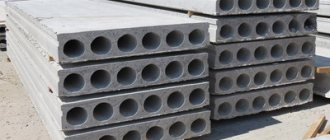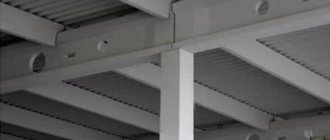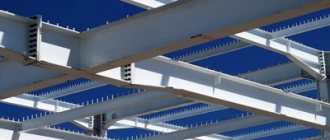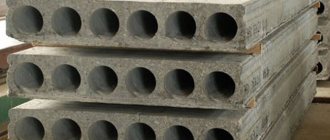This happens because the monolithic belt distributes the total load from the roof through the walls to the foundation.
What is especially important, it helps to prevent negative consequences from soil movement, the influence of external deforming stresses from wind, temperature fluctuations and atmospheric moisture.
The reinforced structure is made monolithic from reinforced concrete or in the form of masonry from ordinary bricks and combines the boxes of the house into a single load contour.
The degree of strength of such a structure and its actual ability to resist loads are determined by the thickness and height of the protective belt, the composition of the concrete, the characteristics of the reinforcement frame, the accuracy of the work technology, in compliance with all relevant norms and standards.
What is it needed for?
A reinforced belt is one of the important protective elements of a construction project for any purpose. It is created at different heights from the “0” ground level, depending on its number of floors and the interfloor distance chosen by the developer. The absence of such a protective structure reduces the strength and durability characteristics of the construction project.
In the design of a house, the armored belt performs the following important tasks :
formation of a strictly horizontal, level base for floor slabs and mauerlat;- uniform distribution of all types of loads created by the roofing system, interfloor ceilings and higher walls;
- protection against box deformation and wall cracking;
- uniform dispersion of stresses acting on the end surface of the walls of new structures;
- creating a stable building in areas with sloping terrain; maintaining the unity of the structure of the facility, built in a seismically active place;
- protecting the house from frost heaving of the soil.
The reinforced protective structure is made in the form of a monolithic concrete or brick closed strip installed along the load-bearing walls of the house.
Existing urban planning norms and rules require mandatory installation of such protection in the following cases :
- when used for the construction of load-bearing walls of buildings made of porous building materials;
- excessive weight of interfloor slabs;
- building block materials of varying strengths are used;
- during construction work in a seismically active area or on moving soils;
- installation of a truss roofing system using studs and anchors is planned;
- the floor beams are laid unevenly, which creates a point load on the weak porous wall material;
- the project provides for the construction of a prefabricated foundation or it will be shallow;
- the house box requires additional rigidity;
- for objects over one floor.
Is it possible to do without it?
The decision to erect such protective structures is made at the design stage of the house . If the calculated local wall stresses and forces cannot lead to cracks, it is allowed not to install the reinforced belt.
In addition, it is also possible not to install monolithic protection when constructing thick main walls made of brick or a foundation that is planned to be deepened below the ground frost level.
An armored belt is not required when creating monolithic wall structures or those made of timber and logs.
Overlapping device
Overlapping according to profiled sheet
For floors, corrugated sheeting with additional stiffening ribs is suitable. The height of the wave must be at least 60 mm, and the thickness of the sheet without external protective coating must be at least 0.7 mm. The only exception to this rule is the creation of an attic floor, since it bears significantly less load than the interfloor.
Before carrying out work, the ceiling is calculated using a profiled sheet, taking into account the following characteristics:
- Dimensions of the building.
- Loads on beams and columns.
When calculating a monolithic floor using a profiled steel sheet, data on cracking in the lower part of the structure are not taken into account. It is imperative to remember about the likelihood of ribs being crushed or deformed during operation. The calculation of the top part of the slab is carried out taking into account all the data, as is done when designing traditional precast concrete structures. Since during operation there is a possibility of slab deflection, the possible size is determined based on the calculated permanent and temporary loads on the structure.
Analysis of this data allows you to select the optimal dimensions of the metal frame. Installation of the structure is very simple, and it can be done without the help of specialists. But the calculation should always be carried out by professionals, since any mistake can lead to the fact that the structure simply cannot withstand the load during operation.
Installation of beam structure
The technology for installing a monolithic floor using corrugated sheets involves the use of beams and columns. Metal pipes, I-beams and channels are suitable for this purpose. The distance between adjacent beams is determined based on the size and shape of the sheet profile. If the profile height is significant, the pitch between the beams can be reduced.
Corrugated sheeting for monolithic floors
The corrugated sheeting is attached to the base of the beam with self-tapping screws with a reinforced drill, which makes it possible not to drill holes in the channel or I-beam. Experts call such self-tapping screws “armor-piercing”, which corresponds to their technical characteristics. Fastening is carried out only in places where the corrugated sheet comes into contact with the beam. Additional fixation is carried out at the joints of the sheets. Here you can use 25 mm self-tapping screws. The pitch between the screws should be about 40 cm. The width of the sheets is butted with an overlap, and the length of the sheets is butted. The corrugations of the sheet should be oriented downwards. At the construction stage, the rigidity of the steel profiled sheet and its compliance with the calculated design parameters must be checked.
Next, the structure is reinforced. The reinforcement is laid in corrugations in the longitudinal and transverse directions. The reinforcement is knitted with wire. It is not recommended to use welding to create a reinforcement cage. Fixatives are used to form a protective layer. A protective layer is necessary in order to minimize the risk of reinforcement coming out of concrete and being exposed to negative environmental factors. The type and size of the clamps are selected depending on the design thickness of the protective layer. After creating the metal structure, you can fill the floor with concrete.
Frame installation
For this purpose, additional supports are used. The minimum thickness of the floor should be 7–8 cm. Concreting is best done across spans. After the concrete has completely hardened on one span, additional supports are removed. The time it takes for concrete to fully mature can vary greatly depending on the ambient temperature. In the warm season, the structure dries completely in about 10 days. At sub-zero temperatures this may take more than a month.
In accordance with SNiP 3.03.01-87, before concreting, the surface of the corrugated sheet must be cleaned of any dirt, oils, debris, cement dust, etc. The surface is washed with water immediately before pouring the concrete mixture. The mixture is poured in layers that should not have breaks or changes in thickness. The concrete is compacted using vibrators. When performing this work, it is necessary to ensure that the tool does not impact the corrugated sheet, reinforcement and other structural elements. The next layer is poured only after the previous one has set.
Materials for construction
The main building materials for their manufacture are :
Reinforced concrete .
A reinforced concrete structure requires the preparation of wooden formwork and a frame made of reinforcement, which are connected together by pouring concrete mortar of the design grade. It is allowed to add additives to increase the strength and other characteristics of concrete.- Red brick .
For brick protective tape, such formwork is not required; the reinforcement is installed directly on the brick, the mesh thickness is over 5 mm. Such a structure can hardly be called a monolith, but its characteristics are quite sufficient to ensure the reliability of small one-story objects. - U-blocks .
Recently, armored belts have begun to be quite widely erected from universal formwork U-blocks, which have additional thermal protection. The use of U-blocks significantly increases the speed of creating a protective structure, due to the ease of installation, the preliminary installation of a support cushion is also not required, and the low weight of the structures does not require the use of additional equipment and lifting mechanisms.
The heaviest and most reliable option is the first, the cheapest, the second, the warmest and most expensive is the third.
Most often, designers choose to install a monolithic reinforced concrete belt. For its use, concrete and reinforcement are used, which have special requirements :
- Concrete mixtures must comply with design documentation for strength characteristics, frost, water and wear resistance and cavitation resistance, and mixtures must be selected in accordance with workability requirements.
- Pouring the structure is allowed only with marked concrete with a quality certificate; it must indicate the brand, manufacturer, and quality characteristics.
- It is not permitted to use concrete purchased in separate batches from different suppliers for pouring concrete.
- The design age of concrete must be at least 28 days.
- For reinforced concrete structures with a high percentage of reinforcement
- above 1.5%, self-compacting concrete solutions are used.
- It is not allowed to lay concrete mortar in the cold season and at temperatures above +40 C.
- Additives to concrete mortar can only be carried out according to the design and do not cause corrosion of the reinforcement structure and embedded parts.
- Sewage and swampy waters cannot be used to prepare concrete mortar; the total salt content of water in terms of Na+ and K+ should not exceed 1500 mg/l.
To reduce the volume of cement when preparing the solution, it is allowed to use large gravel or crushed stone, but there are volume restrictions :
- for gravel, the sand content in the mixture is not higher than 45%, coarse aggregate -55%;
- for crushed stone, the content of sand in the mixture is not higher than 50%, coarse aggregate - 50%.
Requirements for reinforced belt
Regulatory requirements for such protective structures depend on the location of the ceiling .
- The first reinforced belt is poured together with the strip foundation. Its width cannot exceed the permissible range of 0.7-1.2 m, and its height cannot be less than 0.4 m. It is made under all load-bearing walls, both internal and external, thereby becoming a fundamental element that forms the strength of the object under construction.
- The second protective belt is the basement one, installed on top of the foundation blocks, with a width and height of at least 0.4 m. Its task is to evenly distribute the emerging loads on the base of the house building.
If the first belt is missing in the design of the house, it is absolutely futile to implement the second one; it will not work. Only the joint functioning of two belts above and below ensures the stability of the house, even in seismic zones and with moving soils. - The third belt is installed under the ceilings, and the fourth under the roof beams to secure the roof structure using anchor bolts. Thus, it will be able to absorb the total load from the roofing system and must withstand climatic loads arising from the effects of wind and snow cover.
Under slabs
The floor slabs most often used are concrete floor panels with longitudinal round holes, with the design load :
900 kg/m2—for residential construction;- up to 2000 kg/m2 for industrial and public buildings.
To hold them, you will need a reinforced belt with the width of the wall structure or slightly less, up to 0.8 of the wall thickness, to install a heat-protective layer.
The cross-section of the reinforced frame should be rectangular with a height of 1.5 times the width.
To form the internal frame, only material that complies with GOST is used , with a minimum diameter for longitudinal elements of 12 mm and a length of 8 m, and for transverse elements - 8 mm with a pitch of 400 mm. The reinforcement structure must be continuous and installed strictly horizontally.
The frame is made of 2 rows of reinforcement, 2 rods each. Horizontal rods are laid with an overlap of at least 800 mm, which are placed as far as possible from the corners. The rods are connected with knitting wire. At a corner turn it is bent. The reinforcement frame must be filled with a concrete layer of at least 5 cm on all sides.
To prevent the reinforced structure under the floor slabs from becoming a “cold bridge” in the house, it is insulated from the outside with hard or mineral wool insulators. Otherwise, they will become sources of condensation and mold in the room.
Under beams
The protective reinforcement structure along the floor beam must have parts for securing the Mauerlat. Therefore, even at the moment of creating such a belt, studs with D = 12 mm are displayed . The height of their elevation above the finished belt must be at least 40 mm. Threads are made at the ends of the rods, and holes are made in the Mauerlat with the appropriate pitch. Waterproofing is installed on top of the armored belt.
Next, securing the monolithic structure, the Mauerlat is installed along the matching holes, the protruding studs are fixed with bolts. Only after this are the rafters fixed on it, then the rest of the roof is erected.
To prevent the structure from collapsing, concrete mortar is poured with a grade of at least M200. It is allowed to independently prepare the solution in the proportion of cement/sand/crushed stone: 1/3/5.
Armomonolith under beams can be installed in smaller dimensions than for reinforced concrete slabs , since they have a lower weight. The recommended thickness of the structure is 200 mm, and the height is from 250 mm.
Calculation of floors using metal beams
It is necessary to take a responsible approach to performing calculations when deciding to make a floor or ceiling based on steel profiles.
In this case, it is necessary to take into account a number of factors:
- total weight;
- load capacity;
- area of the formed surface;
- distance between beams;
- span width.
The selection of a suitable number of rolled metal products corresponding to the profile height is carried out taking into account the perceived load.
Load bearing capacity is:
- 0.075 t/m2 – for attic floors;
- 0.150 t/m2 – for the basement base and interfloor foundations.
As the span width increases, the height of the steel beams increases:
- strength over a six-meter span is provided by I-beam No. 20 with a profile height of 200 mm;
- when the distance between the walls is reduced to 4 m, I-beam No. 16 with a height of 160 mm can be used.
Knowing the area of the monolithic surface, it is easy to calculate the need for concrete. To do this, multiply the area by the height of the concrete mass. Having a drawing of the reinforcing lattice, you can calculate the need for steel rods to strengthen the base. All calculations are made on the basis of pre-developed design documentation or a working sketch.
However, they also have a drawback - they are susceptible to corrosion.
Support amount
The amount of support of the slabs on the monolithic belt is a very important indicator for installing the ceiling on a monolithic structure. If you increase the maximum support depth, the slab will begin to function as a lever, and under significant loads, a slight rise of the wall above the slab may even occur. Despite the fact that such a process will be invisible to the observer, it will become critical for the integrity of the house box.
In addition, additional loads that arise when installing furniture, household items and interior partitions will also contribute to the formation of cracks in wall structures.
In this regard, the maximum support value for floors is strictly standardized and should not exceed for the following types of installation:
- for wooden beams - 150 mm;
- brick armored belt - 160 mm;
- belt made of U-blocks - 200 mm;
- concrete reinforced belt - 120 mm.
The minimum indicator for supporting has also been established :
- for wooden beams - 80 mm;
- brick armored belt - 80 mm;
- belt made of U-blocks - 100 mm;
- concrete reinforced belt - 65 mm.
Consumables and styling tools
Before constructing a monolithic armored belt, the developer must accurately calculate the volume of basic and auxiliary materials according to the list, which most often includes :
lumber or plywood for formwork;- insulation for thermal protection on the outside;
- M250 concrete mortar or components for its self-production;
- steel reinforcement and angle;
- knitting wire;
- waterproofing;
- high-quality mounting foam;
- fasteners.
In order for the developer to complete the entire technological process of installing the armored belt, you will need to prepare the following set of tools and equipment :
- Concrete mixer, if the concrete mixture will be prepared independently.
- Concrete pump and hoses for mechanical pouring of concrete.
- Buckets for manual concrete pouring.
- Special hook for manual assembly of reinforcement cage.
- Grinder with attachments for cutting reinforcing bars.
- Construction tools: angle, ruler, level, plumb line, for monitoring and adjusting the quality of pouring a monolithic structure.
- Profile ratchet wrench for assembling reinforced frame.
- Drill, screwdriver.
Step-by-step instructions for pouring
Before the process of pouring the reinforced belt, you will need to perform all the preparatory operations to clean the surface of the walls before, perform waterproofing, cut reinforcement for the frame and prepare lumber for the formwork.
The main stages of the technological map for the production of reinforced concrete reinforced concrete belts for floors:
- The formwork structure is assembled from lumber, with vertical and horizontal reinforcement so that the concrete solution does not squeeze out the walls.
- The width of the formwork should be equal to the width of the wall structure minus the thickness of the insulation layer, and the height should be 400 mm. Most often, class 3 boards with a thickness of 20 mm are used as building materials, fastening the elements together with self-tapping screws and further strengthening the structure after 100 cm.
- The reinforcement is cut to specified sizes and in the required quantity.
- They are then placed on clamps/backings along the length of the formwork and tied with wire to form a low layer.
- After this, transverse reinforcement is laid and the top layer is secured.
- The frame is installed in the formwork with inserts installed so that the structure does not touch its walls, with an indentation of 50 mm.
- The frame must be installed absolutely horizontal, control is carried out with a building level.
- They deliver ready-made concrete mortar or prepare it themselves at the construction site.
- They install the concrete pump and stretch the hoses.
- Fill the formwork in one go.
- Concrete is compacted and air is removed manually by piercing its thickness with reinforcement or using vibrating equipment.
- Level the outer layer of concrete to a horizontal level and cover it with polyethylene.
- The formwork is carefully removed after at least 5 days. After which the laying of floor slabs is allowed.
- Before the concrete has completely hardened, it is wetted in hot and dry weather so that the monolithic mass does not crack.
How to lay it correctly?
Installation of monolithic reinforced concrete floor slabs may only be carried out by trained personnel using a truck crane or other lifting equipment, subject to all safety requirements when working with heavy, bulky cargo.
The installation of beams on a monolithic protective structure can be carried out independently, but subject to the precise implementation of the technology for installing wooden structures.
Plates
Before installing the slabs in a place determined by the design, their end voids are walled up with special armored inserts or simply concrete mortar.
This increases the strength of the structure in the most vulnerable areas with maximum loads.
The work is carried out by a team of installers consisting of at least three people using special lifting equipment.
One installer is responsible for slinging and securing the slabs to the hook. The remaining workers are at the laying site, monitoring the position of the slab and disconnecting the crane fasteners.
When performing manipulations with floors, it is contraindicated to turn them over to the opposite side, otherwise they will not withstand the weight for which they are designed.
This feature is explained by the design of the lower part, which is reinforced with reinforcement, preventing tensile forces. Therefore, violation of the installation will lead to structural fractures during the operation of the house. It is not difficult to distinguish the bottom from the top - the bottom is smooth, and the top has roughness.
When installing concrete floor slabs, proper anchoring is required. This is especially necessary for houses over one floor and objects built in seismically active areas.
There are several methods for anchoring panels to each other :
- With the use of reinforcement, when it is attached to the installation loops, and the connection with the load-bearing walls is made using L-shaped reinforcement.
- In the case where there are no mounting loops, the reinforcement is welded to a plate, which is placed in the seam between adjacent slabs, after which the joints are filled with concrete mortar.
Beams
When installing wooden floors, the wall material must be taken into account. So, for aerated concrete under a reinforced belt, a formwork 250 mm high with a simple knitted reinforced frame made of A-III, which is filled with M200 concrete mortar, is sufficient.
After the reinforced belt has hardened and the formwork has been removed, wooden beams are installed, with a thickness that will depend on the thickness of the wall, but not more than 250 mm and not less than 150 mm.
The space for laying beams is determined to be 300-400 mm, and the minimum area of support on the walls is 80 mm.
At the bottom, the beams are hemmed with boards, and vapor and moisture insulation and insulation are placed in the space between the boards. The layout of the cake, the type of insulation, its thickness and the order of protective layers are established by the project.
Mineral wool group material is used as a heat-protective material , and polystyrene foam is not allowed to be used inside a residential building, since it is flammable and emits life-threatening carcinogens. After laying the heat-protective layers, a rough wooden flooring is installed, followed by a layer of finishing, for example, with OSB boards.
This floor design is quite durable, warm, soundproof and has a long service life. It is quickly installed and does not overload the walls. It is also easy to repair, update and dismantle.
Flooring on I-beams - preparatory work
At the preparatory stage, perform the following activities:
- Decide on the material that is supposed to be used to make the ceiling of the room, and also study the sequence of actions.
- Develop a working drawing that provides complete information about the design features of the ceiling and the range of materials used.
- Perform calculations confirming the strength characteristics of the building structure and the safety margin necessary for long-term operation.
- Calculate the need for building materials, estimate the amount of expenses, and prepare tools.
- Mount the I-beams, maintaining an interval between the supporting elements of 1–2 m and check the correct installation using a level.
- Assemble panel collapsible formwork along the lower level of the I-beam using laminated plywood or planed boards, provide a flange 15–20 cm high.
- Anchor wooden beams or steel spacers to ensure the formwork structure remains stationary and must support the mass of concrete.
When installing supports, install one wooden beam for each square meter of area, and metal elements 2 times less often. The use of telescopic racks will significantly facilitate the work of fixing the formwork structure. Having completed the preparatory activities, proceed to the main work.
Correct calculation of flooring on metal beams is very important
Bugs and difficulties
An armored belt installed in accordance with the standard and the project guarantees a long service life of the object, since it increases its strength and performance characteristics.
The main difficulties in implementing such a protective structure arise for developers in the process of design calculations , which are quite complex and require special ones when choosing the volume of materials, dimensions and technical parameters.
It is recommended to entrust this part of the work to professionals so that all the necessary package of project documents is completed efficiently. Having a project in hand, you can build an armored belt yourself.
The main mistakes that developers make in the process of creating a protective belt for floors:
- During the installation of formwork: the lumber was chosen incorrectly, waterproofing was not carried out and the horizontal level was not maintained.
- After pouring concrete, the reinforcement is not filled with concrete and has air access to the frame elements, which is fraught with the appearance of corrosion processes.
- Concrete was poured in several stages and from different batches.
- Violation of the percentage composition of concrete components.
- Concrete was not wetted at high ambient air temperatures.
Advantages and disadvantages of flooring on metal beams
The design with load-bearing elements made of rolled steel has a number of advantages:
- increased reliability;
- high safety margin;
- long service life;
- increased load-bearing capacity.
By using metal structures made from steel profiles, it is possible to cover spans of increased dimensions by correctly selecting the number of rolled products used.
[testimonial_view id=”19"]
Along with the advantages, there are also weaknesses:
- the complexity of installation work associated with the increased weight of metal structures and the need to transport them using special devices;
- the need to perform complex engineering calculations confirming the load capacity of foundations being constructed based on steel profiles.
Disadvantages also include the metal's susceptibility to corrosion processes, which reduce the strength of structures. However, with the help of special coatings it is possible to reliably protect the metal and ensure the durability of metal structures throughout the entire period of operation of the building.
Metal beam ceilings are very durable and reliable











